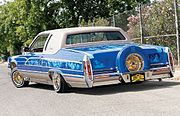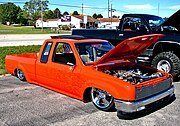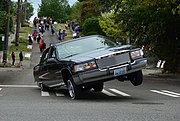Old Lowriders

A 1962 Pontiac Catalina with lowered body in the lowrider style.
A lowrider or low rider is a customized car with a lowered body.[1] These customized vehicles are generally individually painted with intricate, colorful designs, rolling on wire-spoke wheels with whitewall tires. Lowrider rims are generally smaller than the original wheels, ranging down to 13 inches (330 mm). They are also fitted with hydraulic[2] or air bag systems that allow height adjustable suspension, where the vehicle is raised or lowered at the owner's command.[3] Given these specific characteristics, while a lowrider is always a lowered car, a lowered car is not always a lowrider. The term is used to describe a class of vehicle, not simply the height from ground to chassis.
The term lowrider can also refer to the driver of the car.
Origin and purpose [edit]

Test of a 1964 Chevrolet Impala hydraulic system

Cadillac in low position

Nissan Lowrider pickup in Piketon, Ohio 2008 with suspension in low position

The lowrider car serves no practical purpose. Lowrider car culture began in Los Angeles, California in the mid-to-late 1940s and during the post-war prosperity of the 1950s. Initially, some Mexican-American youths lowered blocks, cut spring coils, z'ed the frames and dropped spindles. The aim of the lowriders is to cruise as slowly as possible, "Low and Slow" being their motto. By redesigning these cars in ways that go against their intended purposes and in painting their cars so that they reflect and hold meanings from Mexican-American culture, lowriders create cultural and political statements that go against the more prevalent Anglo culture.[4] However, this resulted in a backlash: the enactment of Section 24008 of the California Vehicle Code on January 1, 1958, which made it illegal to operate any car modified so that any part was lower than the bottoms of its wheel rims.
Adding height adjustable suspension [edit]
In 1959, a customizer named Ron Aguirre developed a way of bypassing the law with the use of hydraulic Pesco pumps and valves that allowed him to change ride height at the flick of a switch.[5]
Role of Chevrolet Impala [edit]
The preceding year, 1958 saw the emergence of the Chevrolet Impala, which featured an X-shaped frame that was perfectly suited for lowering and modification with hydraulics.[6] On this car, the standard perimeter-type frame was abandoned, replaced by a unit with rails laid out in the form of an elongated "X." Chevrolet claimed that the new frame offered increased torsional rigidity and allowed for a lower placement of the passenger compartment. This was a transitional step between traditional perimeter frame construction and the later fully unitized body/chassis, the body structure was strengthened in the rocker panels and firewall. This frame was not as effective in protecting the interior structure in a side impact crash, as a traditional perimeter frame.[7]
Lowrider culture [edit]
Between 1960 and 1975, customizers adapted and refined GM X-frames, hydraulics, and airbrushing techniques to create the modern lowrider style.[8]
At first, lowriders were only seen in places like Los Angeles, especially in the 1970s on Whittier Boulevard when lowriding came to its peak. Whittier was a wide commercial street that cut through the barrio of the city in Los Angeles, California. On Saturday nights, young Chicanos went cruising along Whittier blvd in their lowriders.
Expanded audience in U.S. [edit]
In the 1990s, lowriders became strongly associated with West Coast Hip hop and G-Funk culture. Dr. Dre, Snoop Dogg, Game, Warren G, South Central Cartel, Eazy-E and Above the Law among others featured lowriders prominently in their music videos.[9]
Today, the lowriding scene is diverse with many different participating cultures, vehicle makes, and visual styles. Lowriders today can be seen all over the country, but recently they have been spreading to other places around the world as well.
Expanded audience in Japan [edit]
Lowriding culture has also spread to Japan.[10] [11] [12]
Junichi Shimordaira continues to import and sell these cars through his business, Paradise Road.[13] The spread of lowrider culture and the fame of Paradise Road even raised the attention of Ed Roth, who is famous for creating custom cars such as hot rods and a prominent figure in Kustom Kulture.[14] Since the introduction of lowriders in Japan and the rise of lowriders in Japan in 2001, it is estimated that there are still 200 car clubs that are related to the lowrider scene that are still active to this day.[15]
Types [edit]
- Cal Style VW (a latter day, "bomb lowrider" based on a Volkswagen Type 1, not to be confused with a Cal looker)
- Hi-Riser (automobile)
- VIP style
See also [edit]
- Lowrider bicycle
- Low Rider — song by the band War
- Lowrider magazine
- Chicano Rap
- Gangsta Rap which includes the track: Ridin' Low
- G funk
- Kid Frost
- Hot rod
- Hi-Riser
References [edit]
- ^ Hamilton, F. (1996). How to Build a Lowrider. S-A Design Series. Cartech. p. 6. ISBN978-1-884089-18-3 . Retrieved 9 January 2020.
- ^ Stavans, I.; Augenbraum, H. (2005). Encyclopedia Latina: history, culture, and society in the United States . Encyclopedia Latina: History, Culture, and Society in the United States. Grolier Academic Reference. p. 51. ISBN978-0-7172-5818-5 . Retrieved 9 January 2020.
- ^ Lowride Magazine; Lowrider Editorial Staff (2002). The Lowrider's Handbook. Penguin Group (USA) Incorporated. p. 69. ISBN978-1-55788-383-4 . Retrieved 9 January 2020.
- ^ Sturken & Cartwright, Marita & Lisa (2009). Practices of Looking: An Introduction to Visual Culture. Oxford University Press. p. 80. ISBN978-0-19-531440-3.
- ^ "Cruising into History under the Law's Nose". Michigan State University. Retrieved 24 August 2020.
- ^ "Going "Low and Slow" in East Los Angeles". The Golden State Company. Retrieved 24 August 2020.
- ^ Niedermeyer, Paul (19 January 2012). "Automotive History: An X-Ray Look At GM's X Frame (1957 – 1970)". Curb Side Classic . Retrieved 28 February 2015.
- ^ Rong, Blake (16 July 2016). ""Ghetto Famous" Lowriders Reach For The Sky In Odessa, Texas". Road & Track Magazine. Retrieved 24 August 2020.
- ^ Strait, Kevin. "Lowriders and Hip Hop Culture". Smithsonian . Retrieved 30 August 2021.
- ^ DELGADILLO , NATALIE. "Meet the Chicanos of Japan." Google, Google, 2 Feb. 2017, www.google.com/amp/s/www.citylab.com/amp/article/515388/.
- ^ Frost, Bob. "History of Lowriders". www.historyaccess.com.
- ^ Lowrider History; convictedartist.com; retrieved on 2010-11-25.
- ^ Lirones, Brett. "Here's Why You'll Find American-Styled Lowriders Roaming Around the Streets of Japan". Hagerty. Hagerty. Retrieved 5 May 2019.
- ^ Mendoza, Beto. "Paradise Road - Shop Stop & Talk". Lowrider. Lowrider. Retrieved 5 May 2019.
- ^ Donoghue, JJ. "The Elaborate Customized Cars of Japan's 'Lowriding' Subculture". CNN. CNN. Retrieved 5 May 2019.
Further reading [edit]
| | Wikimedia Commons has media related to Lowriders. |
- Brown, J (2002). "DIPN The Industry of Low Riding", Dream Factory Films, 1(2)(3).
External links [edit]
- Lowriders, NMAAHC
- Lowrider: DIY car magazine that became voice of Mexican-American resistance, The Guardian
Source: https://en.wikipedia.org/wiki/Lowrider







Tidak ada komentar:
Posting Komentar